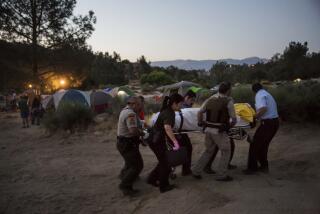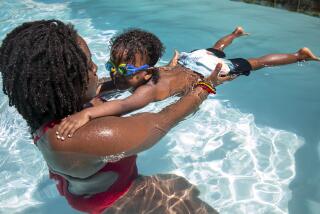Different Strokes for Wee Folks
- Share via
Thousands of Ventura County children--infants to toddlers to grade schoolers--will be enrolled in swim lessons this summer as their parents try to give them the basics in a pastime that is supposed to be fun--but can be fatal.
Swimming safety has received heightened awareness in the past week with the drownings of three children in the region, but experts agree that lessons don’t guarantee safety.
“When you have a pool in the backyard, it’s a matter of supervision,” said Ingrid Daland, who runs a swim school in Thousand Oaks. “Nobody is ever pool-safe. . . .You have to watch all the time.”
Over the weekend, three children drowned in backyard swimming pools. A 4-year-old boy died during a birthday party at rock musician Tommy Lee’s Malibu home. A 3-year-old boy in Chino drowned after being left alone for a short time in his father’s swimming pool, and a 3-year-old girl drowned after apparently falling into her family’s swimming pool in La Palma.
Drowning is the leading cause of death in California among children ages 1 and 2. Statewide, 107 children under age 14 drowned in 1999, the latest year data were available, according to the state Department of Health Services.
Instructors continue to grapple over what age is best to teach a child to swim.
Last year, the American Academy of Pediatrics issued a policy stating that children under age 4 are not developmentally ready for swimming lessons.
“There was a perception that if you have a child who has swimming lessons and ‘can swim’ they are drown-proof. . . .These classes for young children were establishing a false sense of security,” said Gary Smith, director of the Center for Injury Research and Policy at Children’s Hospital in Columbus, Ohio. Smith helped write the pediatrics academy’s policy.
Aquatic programs for infants and toddlers have not been shown to decrease the risk of drowning, and small children have not developed the neuromuscular capacity required for swimming skills, according to the policy statement.
“There’s no real advantage to starting earlier,” Smith said. “If you want to have your child in the water for the enjoyment of it, that’s great. But it shouldn’t be translated to mean your child will be safe around water.”
Infant and preschool swim programs have been developed by organizations such as the American Red Cross and the YMCA, but these programs center more on providing enjoyment and are not designed to teach children to survive independently in the water.
“They do a lot of water comfort type activities to make those children very happy in the water,” said Steve Willmont, executive director of the Conejo Valley YMCA in Thousand Oaks. “It’s all about making sure the child feels comfortable in the water so they are better prepared when they take swim lessons.”
In her classes, Daland teaches children how to get back to the wall of the pool.
“Once they get to the wall we teach them to hold on and climb out and then sit down so they won’t step back in the water,” said Daland, who has run the swim school for 16 years.
Jill Roberts of Simi Valley brought her 15-month-old daughter, Meaghan, to Daland Swim School.
“We have a pool in the backyard, and I wanted to introduce her to the water so she’s not scared,” Roberts said. “But a big part of it is the safety thing. In case she would ever slip, hopefully she won’t panic because she knows what to do.”
There also are things parents can do to head off disasters, Daland said.
Even if a backyard swimming pool has a fence around it, one side is typically accessible from the house, which should have a barrier to prevent children from wandering in. Toys should be put away when they are not being used in the pool. And the pool should have places along the side for a child to grip onto, she said.
“People have beautiful pools with a 3-foot tile wall around them, but when a child falls in, there is nothing to hold onto,” Daland said.
At summer pool parties, one parent should be designated to watch the pool at all times and children can wear life vests for extra protection.
“That way, if you turn your head, the child will be OK,” she said.
More to Read
Sign up for Essential California
The most important California stories and recommendations in your inbox every morning.
You may occasionally receive promotional content from the Los Angeles Times.













